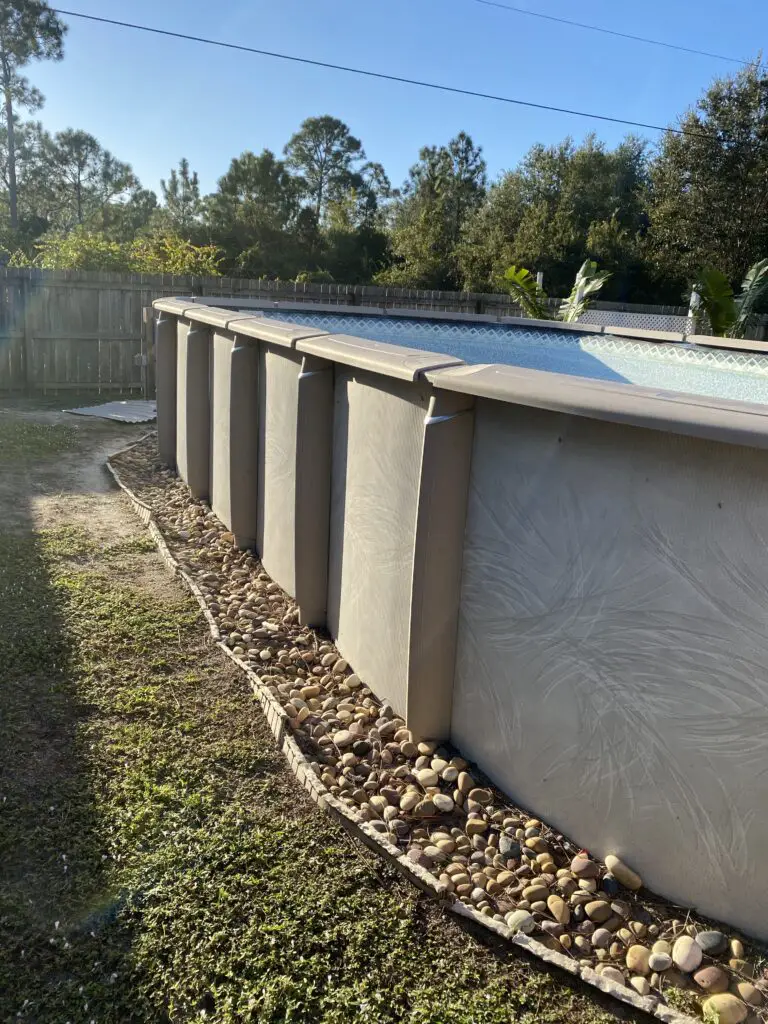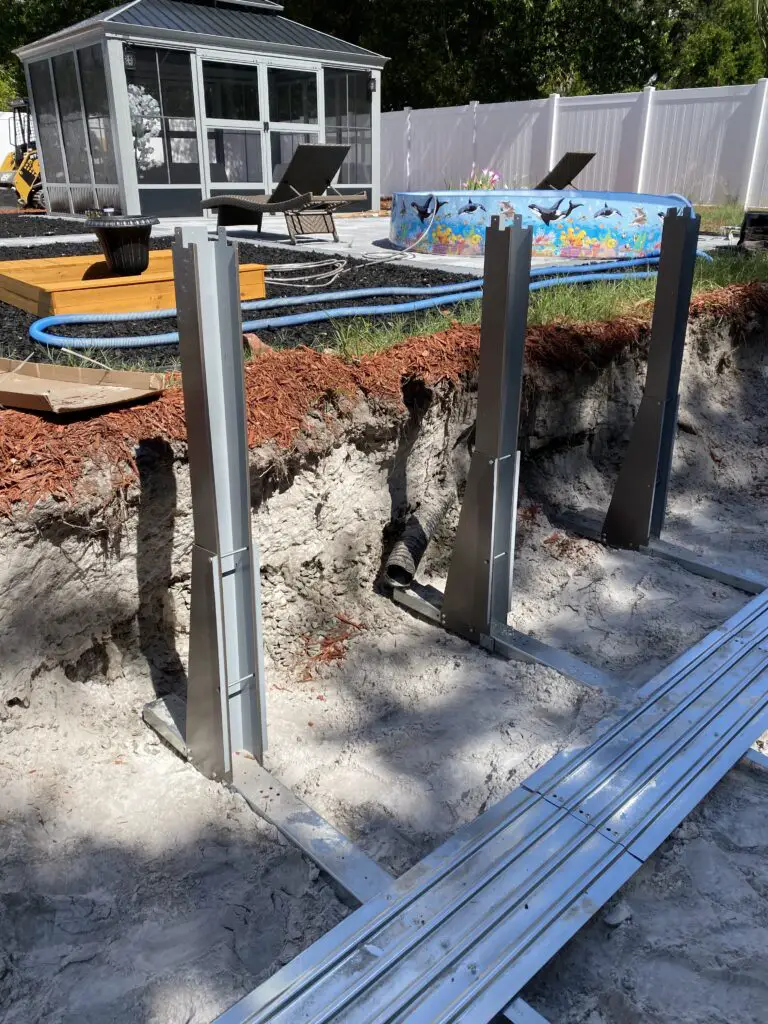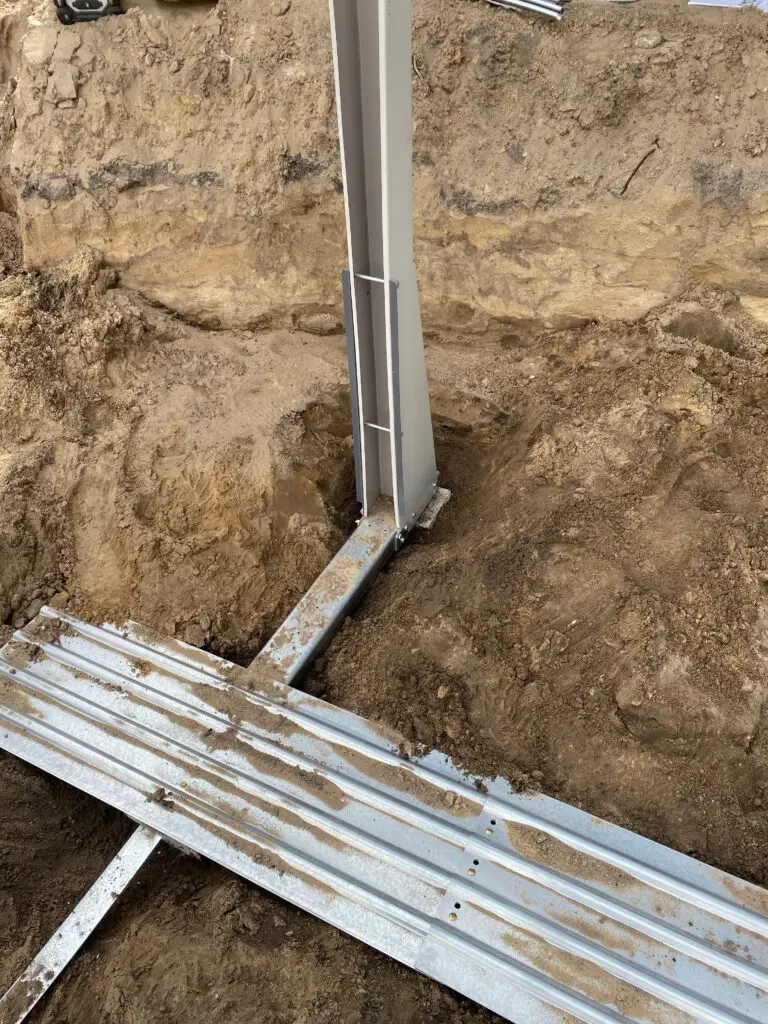Not all oval above ground pools are the same. There are a couple of designs that take more space in the yard and some don’t allow for certain things. Here’s a breakdown.
The two big differences with oval above ground pool designs are the dimensions of the buttresses and whether or not they have straps running underneath them. The buttresses can range from sticking out from the outside of the pool only 6″ to as much as 3′ 3″.
THE ANATOMY OF AN OVAL ABOVE GROUND POOL
When it comes to metal walled above ground pools, there are two main choices – Round shaped and oval-shaped (Rectangle above grounds are rare and expensive, so I don’t add them). Round shaped pools are an easy design. They are easy because the round shape evenly distributes the weight of the pool water, so it requires no extra support.
Oval pools have straight sides to them. This means that they need something to support the weight of the water on the straight sides. The round ends of the oval don’t need anything and are designed simply just like a round pool.
To keep the straight sides of an oval upright when all that heavy water goes into the pool, they have what is called buttresses.
WHAT IS A BUTTRESS?

Buttresses are an architecture design to hold tall walls in place. They date back before the Roman era but it was the Romans that perfected them. They provided support for walls so they wouldn’t fall outward or inward. With the use of buttresses, walls can be built much higher.
When it comes to holding water in place with just a thin metal wall, buttresses are perfect. They protrude outward and inward at the bottom of the wall to keep it from tilting. What this means to you in terms of installing or having an oval pool is that those buttresses take up space both in the inside and outside of the pool at the straight sides.
In addition to an oval pool needing buttresses to keep the straight sides from tilting, it also needs something to prevent the straight walls from pushing outward. This is done by either connecting the opposing sides with straps underneath or reinforcing the bottom of the buttresses with solid concrete blocks.
Most oval pools have straps that run underneath the pool and connect with the opposite buttress on the other side of the pool. These connected straps cause the buttresses to pull against each other as the pool fills with water. This will keep the walls of the pool from pushing out.
The other design used to keep the straight walls from pushing out from the weight of the water is by reinforcing the bottom of each buttress with a concrete block filled with concrete. With this, the water weight pushes against the buttresses but cannot move them because the solid blocks are buried behind each buttress. The buried blocks cannot move because they are in the ground and heavy.
So, an oval above ground pool has two radius ends which are curved and designed just like a simple round pool and then buttresses with either straps or solid concrete blocks along the straight sides.
DIFFERENT BUTTRESS DESIGNS

There are about a dozen different buttress designs used for oval pools. Each are similar but have different dimensions. This is important for the installation as some need more area to level.
Less expensive models will have very large and visible buttresses that stick out beyond the pool wall quite a bit. As an example, Wilbar has a design that has each buttress go out about 3ft, 3” from the pool wall. And the buttress makes a triangle connecting from the farthest point (3ft, 3”) to the wall of the pool. This design is an old school one and is very visible and unattractive.
Other designs aren’t as visible and don’t take up as much space on the outside of the pool. An example of this is a Wilbar model that only protrudes 1ft, 3” out from the wall of the pool and the actual buttress structure only comes out about 10” away from the wall. This makes for a very streamlined look.
NOTE: If choosing to install an oval on a concrete slab, know the dimensions of the buttress design of the oval that you bought before building the sandbox.
BUTTRESS-FREE DOES NOT MEAN IT DOESN’T HAVE BUTTRESSES

The terms “buttress-free” or “buttress-less” is deceiving. Every oval above ground pool has to have buttresses. Period. What is meant here is that there are some oval models that have buttresses that are just upside-down T-shapes. And the “T” part that protrudes outside of the pool is almost completely buried.
This makes buttresses look just like the rest of the normal uprights for the pool. This is a nice looking design and I’m seeing it more and more lately.
Expect to pay more for the more streamlined buttress designs. They don’t necessarily mean they are better, go together straighter, or last longer, but they look much better and take up less space.
STRAPPED AND STRAPLESS OVAL POOLS
Most mid-range to better quality above ground swimming pools are made by an umbrella manufacturer named “Wilbar”. I bring this up because Wilbar ovals are almost all strapped designs. As a result, most oval pools for sale and in existence will have straps running underneath them.
When it comes to non-strapped ovals, Doughboy is responsible for most of those. This is because at one time, that was all Doughboy offered. This was their old school model that has been made for decades. Doughboy has a sister company named “Lomart” that makes both strapped and strapless oval pools.
Lomart actually makes a couple of oval models that can be either strapped or strapless, which is kinda cool. The pool comes with straps and the angle brackets that are used for the solid concrete block design.
OVAL AND RECTANGLE ABOVE GROUND POOL ARE NOT THE SAME THING
Oval above ground pools are very common and popular, while rectangle above grounds are not. I’m only talking about the metal walled pools here. The cheaper soft-sided pools sold by Walmart have some rectangle pools that are around.
Rectangle above ground pools take a lot more to install and cost a lot more to buy. They need buttresses on all sides of the pool as there are no rounded ends. Rectangle pools have a lot of straps and are trickier to install. If your heart is set on a rectangle pool, make sure you find an installer before you buy one because you may not find anyone to install it.
ADVANTAGES TO GETTING A STRAPPED OVAL ABOVE GROUND POOL
1 More models to choose from and more available – As stated earlier, most ovals have straps, so they will be easier to get than non-strapped pools. And there will be a lot more models and manufacturers to choose from.
2 More margin for error for do-it-yourselfers – Since each buttress is attached by straps, the dimensions across the oval are definite. This makes for less error. Just make sure to square the straight sides of the pool with each other.
3 Installers are more experienced with strapped ovals – If you are going to have your oval installed (which I recommend), then you’ll want installers to be more comfortable with it. Not everyone who installs above ground swimming pools have much experience with any oval, let alone the rarer “strapless” type.
As an installer of about six thousand pools over a span of 34 years, I’ve built every type of above ground pool there is. And even with me, I would prefer to install a strapped oval over a non-strapped model. This is only because I am more used to the strapped ones.
ADVANTAGE TO GETTING A “STRAPLESS” OVAL ABOVE GROUND POOL
1 You can have a deep end or deep center – Straps for an oval run just underneath the bottom of the pool. This makes it impossible to have a deep end. You could technically have a small hopper at the end of a strapped oval, but it’s not worth it.
A strapless oval can accommodate a deep center/end nicely.
2 You cannot feel or see the straps – Sometimes, the straps in an oval will raise up when the pool is filled with water. This may be from an installer’s mistake or a design flaw. Visible straps are harmless but can be annoying. A strapless oval cannot do this because there are no straps.
ALL OVAL ABOVE GROUND POOL DESIGNS ARE A CHALLENGE
There are a couple of oval models that are easier to build than the others. And some are designed better, which means they will come out straighter and have fewer issues going together.
All oval designs and models are not great though. This is coming from an installer who has built them all and understands above grounds well. I wish makers like Wilbar and Doughboy would do a better job with designing their oval pools, but in more than three decades that I have built them, manufacturers have made no progress in this regard. Ovals have instead, become more complicated and have worse designs than they did several years ago.
I’m venting here for a reason. If you get an oval above ground, don’t expect perfection. If you are paying an installer, he may know what he is doing and the one or both straight sides may not come out straight. And there may be a bit of a “dog leg” where the straight side meets the radius of the pool. That could be just as good as it can get.
Also, if you are self-installing an oval, don’t beat yourself up if you have some issues. It may just be one of the many design flaws some of these ovals have. You, of course, want to do as good a job as you can. But in the end, the imperfections may not be your fault. Ovals can just suck. Period.

We have a very old above ground pool. We have only owned the house for 2 years so we don’t know much about the pool. We want to install river rock and a walkway around the pool, but I am concerned that the landscaper has to excavate (manually by shovel) in order to make the ground level for this rock. If he removes 2-3 inches to level the ground, will that compromise the structure and support? After doing some research I see that we have the buttress design with the beams that stick out. I also know from previous pool companies that assisted us with the liner, that the pool wall is in the ground by a few inches. Any advice would be greatly appreciated.
Hi. You will be ok. As long as they don’t dig under the pool wall and not harm what is supporting the outside portion of the buttresses, it’s all good to dig around that area a couple inches down.